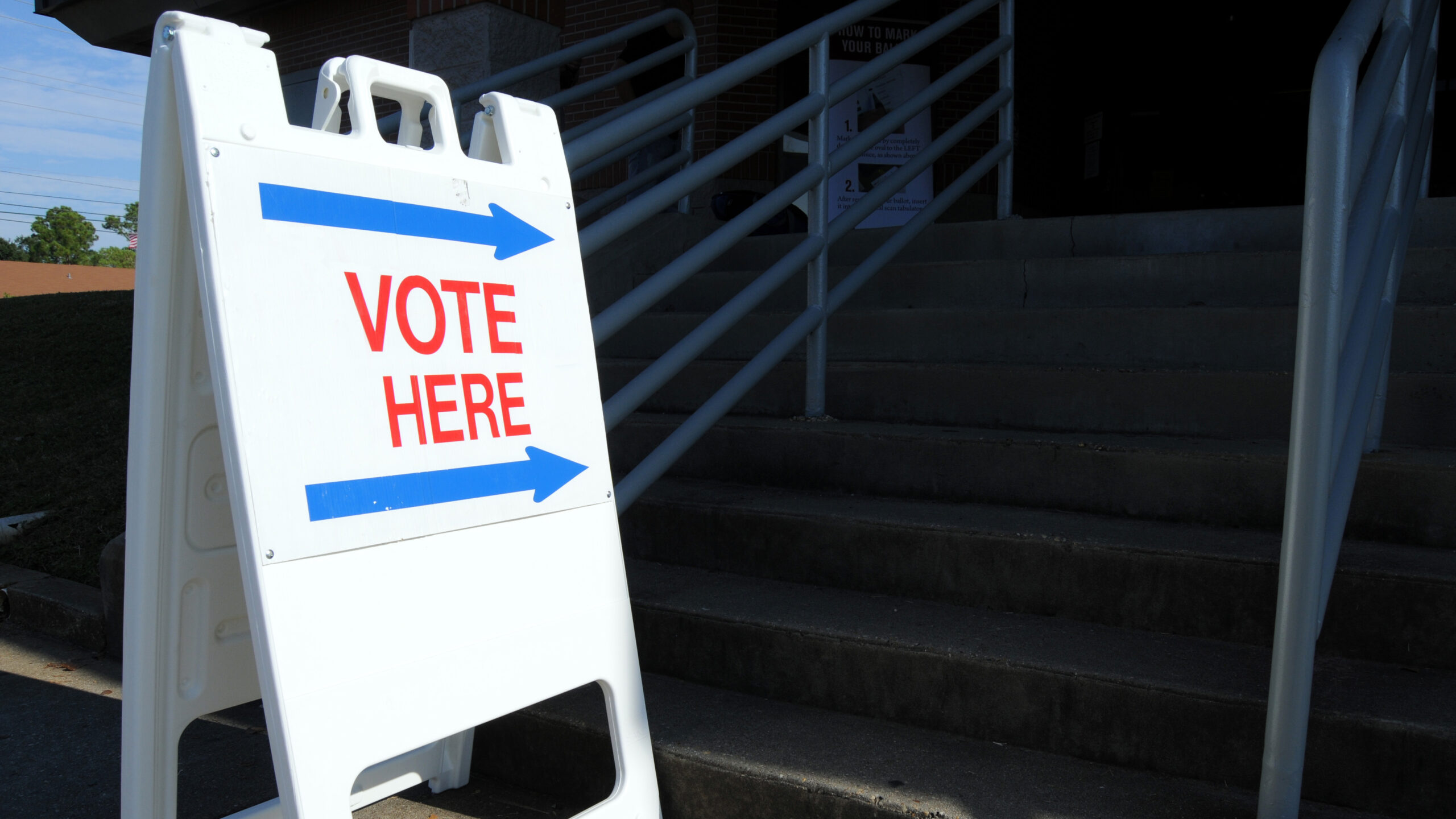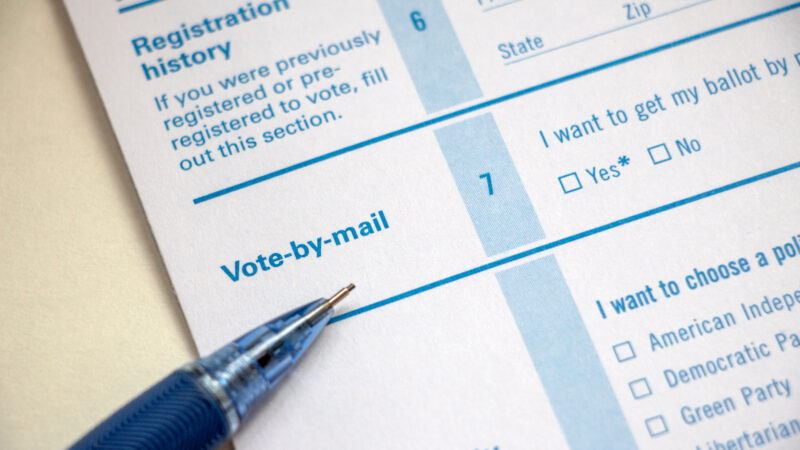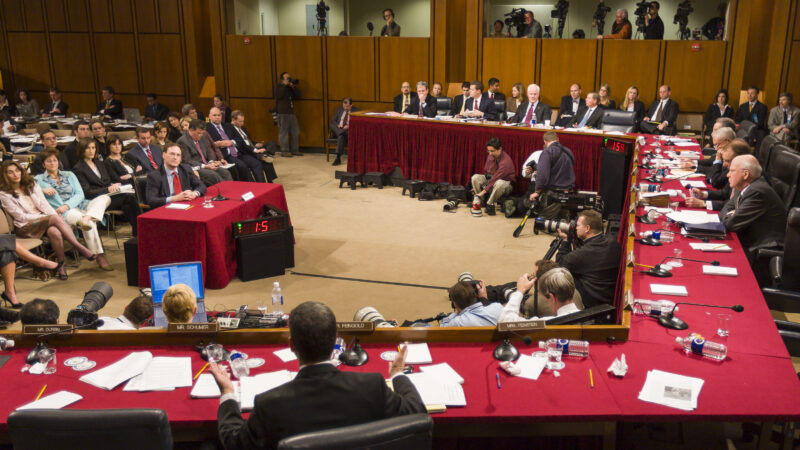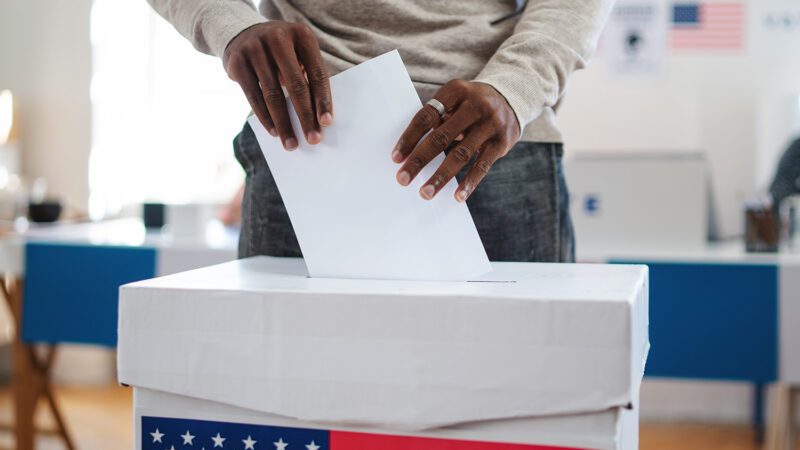Before joining Protect Democracy, Cameron was an associate at Gibson, Dunn & Crutcher and served as a clerk on the Fifth Circuit Court of Appeals.
Free speech and voter intimidation after Counterman v. Colorado
- July 7, 2023
How to defend Section 11(b) of the Voting Rights Act under the updated “true threats” exception to the First Amendment

Section 11(b) of the Voting Rights Act of 1965 prohibits electoral intimidation. It makes it illegal to threaten, coerce, or intimidate voters, election officials, and anyone urging or assisting someone to vote. And, perhaps most importantly, it sets out an objective standard for determining liability: that is, to establish a violation of Section 11(b), a plaintiff does not need to show that the intimidator acted with a specific intent to intimidate. Instead, a Section 11(b) plaintiff merely needs to show that an intimidator took actions that would intimidate, threaten, or coerce an objectively reasonable voter. (Subjective standards differ from objective standards insofar as subjective standards require proof of a particular defendant’s personal mindset in taking an action whereas an objective standard simply requires looking at what a defendant did and asking how that conduct would have been perceived by a reasonable individual.) As a result, Section 11(b) has seen a resurgence in use in recent years (led, in part, by Protect Democracy), as voting rights lawyers work to combat an ever-increasing tide of electoral intimidation across the country.
Enter the Supreme Court’s recent ruling in Counterman v. Colorado. The Court has recognized certain historical categorical exceptions to the First Amendment — such as true threats, obscenity, fighting words, and fraud — that can be prevented and punished without raising “any Constitutional problem.” Counterman considered the breadth of one of those exceptions — specifically the “true threats” exception — and asked two questions:
- Does the First Amendment impose a subjective or an objective true threats standard? In other words, does a speaker have to issue a threat with a particular mental state before it falls outside of the First Amendment? Or can we ignore the speaker’s subjective intent and ask whether a speaker’s words were objectively intimidating?
- If the First Amendment’s true threats exception has a subjective intent requirement that requires someone to act with a particular mental state to commit a true threat, what mental state is required? Do you have to show that someone acted purposefully to threaten? Or do they have to act with knowledge that someone will be threatened? Or is it merely enough to show that someone acted recklessly in speaking the threatening words by consciously disregarding the risk that the words would be perceived as threatening?
The Court answered with what it termed a “goldilocks” solution: it concluded that the true threats exception does have a subjective intent element, but that threats need only be uttered recklessly before they fall outside of the First Amendment’s protection. As a result, the Court vacated the stalking conviction at issue in Counterman because the jury had only considered under then-binding Colorado precedent whether Counterman’s conduct was objectively intimidating.
After Counterman’s embrace of a subjective recklessness standard, some may wonder about the constitutionality of Section 11(b)’s objective standard for determining liability. In particular, if Section 11(b) of the Voting Rights Act has an objective standard for determining liability and does not require any showing of an intent — let alone a reckless one — and Counterman requires that a threat be issued recklessly before it falls outside of the protections of the First Amendment, then does Counterman imperil the constitutionality of Section 11(b)? And would federal courts then need to use the constitutional avoidance canon to read a recklessness element into Section 11(b) in at least some cases?
Plaintiffs should be able to show that the application of an objective standard for judging liability under Section 11(b) poses no First Amendment problem whatsoever.
The best answer to those questions is “no.” But, given that Counterman heightens the standard for what constitutes a true threat, some Section 11(b) plaintiffs — specifically the ones that do not allege that the defendant acted with an intent to intimidate — can no longer use the categorical true threats exception to justify the constitutionality of the application of Section 11(b) to their claims. Nonetheless, plaintiffs should be able to show that the application of an objective standard for judging liability under Section 11(b) poses no First Amendment problem whatsoever.
That is so for three interlocking reasons:
- First, Section 11(b)’s wide potential application to non-speech conduct gives it a sufficiently legitimate sweep to defeat any “facial” challenges that would invalidate Section 11(b) in its entirety, meaning that challengers to Section 11(b) should be limited to arguing that Section 11(b) is unconstitutional in their particular case based on their particular conduct. (“Facial challenges” seek to invalidate a statute in its entirety while “as-applied challenges” seek to only invalidate a statute with respect to its application in a particular case with respect to a particular set of facts, but, as a result, individuals bringing a facial challenge must make a heightened showing of unconstitutionality because of the broader implications of a facial challenge.)
- Second, with challengers limited to only as-applied challenges based on the facts of their particular case, many Section 11(b) plaintiffs will be able to invoke other categorical exceptions to the First Amendment to establish that a defendant’s speech or course of conduct falls entirely outside of the protections of the First Amendment even if a defendant’s actions do not constitute a true threat under Counterman.
- Third, even where no categorical First Amendment exceptions may be invoked, Section 11(b) can still regulate First Amendment protected speech because it can survive any potentially applicable level of scrutiny — up to and including strict scrutiny.
Section 11(b)’s wide application to both non-speech conduct and clearly proscribable speech should inoculate it against any overbreadth challenge.
Overbreadth challenges are a special kind of facial constitutional challenge permitted in the First Amendment context that allow defendants to facially invalidate a statute as unconstitutional even when that statute can be constitutionally applied to them (the usual rule is that challengers can raise only their own constitutional challenge and that statutes can only be facially invalidated when there’s “no set of circumstances” where a law can be constitutionally applied). And overbreadth challenges can be particularly appealing to defendants in voter intimidation cases because they can shift the discussion from the conduct that defendants engaged in (which is usually less-than-ideal) to a series of counsel-constructed hypotheticals. But precisely because overbreadth challenges invalidate statutes that may be constitutionally applied in at least some circumstances, the Supreme Court has set a high bar before overbreadth’s “strong medicine” may be applied: “a law’s unconstitutional applications must be realistic, not fanciful, and their number must be substantially disproportionate to the statute’s lawful sweep” to “justify facial invalidation.” Thus, “[r]arely, if ever, will an overbreadth challenge succeed against a law or regulation that is not specifically addressed to speech or to conduct necessarily associated with speech.”
Under that standard, Section 11(b) should survive any overbreadth challenge because it is neither addressed to speech nor to conduct necessarily associated with speech. History shows that there are a lot of ways to violate federal voter intimidation law through non-speech conduct that is entirely unprotected by the First Amendment. For example, pepper spraying voters violates federal voter intimidation law, and there’s no First Amendment right to use pepper spray. Likewise, intimidating driving tactics can violate federal intimidation law, and again, there’s no First Amendment right to break traffic laws and create road hazards. The same is true for evicting voters and denying them credit (as well as outright violence). It’s also true with respect to intimidation by government officials, as government actors often have circumscribed First Amendment rights. In all of those cases it can’t be a First Amendment problem for Section 11(b) to have an objective standard for judging liability because the underlying conduct isn’t protected by the First Amendment. So those plainly constitutional applications of Section 11(b) should also provide a firm firewall against any overbreadth challenge.
Read more: 'Trump Train' Texas Attack Lawsuits Read more: 'Trump Train' Texas Attack Lawsuits
Moreover, even where Section 11(b) is applied to speech, there’s still plenty of potential post-Counterman constitutional applications of the statute to true threats that should also preclude a successful overbreadth challenge. After all, federal voter intimidation law also prohibits threats of violence, and even after Counterman, Section 11(b) still properly reaches all defendants who are found to have subjectively and recklessly intended to threaten someone. That’s potentially far from a narrow category of cases: as the Court in Counterman made clear, a defendant acts with the lower, subjective recklessness degree of fault when they “consciously disregard a substantial risk that [their] communications would be viewed as threatening violence.”
Thankfully, the Court’s defamation precedent provides a ready body of law on what constitutes reckless disregard, and those cases make clear that the recklessness bar is one that can be surmounted. For example, plaintiffs will be able to argue that a defendant “recklessly disregards” a risk when they “consciously avoid” it or disregard obvious problems. And perhaps most importantly, at least in the defamation context, there is an objective backstop to reckless disregard. A defendant publishes a statement with reckless disregard of the truth when their claims are “so inherently improbable that only a reckless [person] would have put them in circulation.” By the same token, plaintiffs who show that a defendant made a statement so inherently threatening that only a reckless person would have assumed it not threatening should be able to succeed in proving that a threat was unprotected, particularly at the motion to dismiss stage.
As a result, the combination of Section 11(b) application to non-speech conduct as well as its application to many true threats even after Counterman should provide Section 11(b) with a more-than-sufficient “legitimate sweep” to counter any overbreadth challenge. (Indeed, the size of that sweep could be even larger depending on how the courts resolve another split in authority between courts that believe that true threats are limited to threats of violence and those which believe that the exception sweeps more broadly, a split that was neither addressed nor definitively resolved by Counterman. While noting universal agreement that true threats include threats of violence, the decision never said that threats of non-violent injuries, such as deportations, evictions, economic retaliation, as well as tortious conduct, are entirely excluded from ever constituting true threats.)
That means constitutional challengers to Section 11(b) should be, as a practical matter, left to only as-applied constitutional challenges. In such a world, the first thing voting rights counsel should do when evaluating a voter intimidation case is to look for non-speech conduct that falls entirely outside of the First Amendment and focus on why that conduct violates federal law because an as-applied challenger is limited to only the facts of their case. And if counsel can find such activity, then any First Amendment challenge can be easily defeated.
Even in cases where the intimidation is primarily occasioned through speech that does not constitute a true threat after Counterman, other categorical exceptions to the First Amendment may provide an alternative basis for defending the constitutionality of applications of Section 11(b).
The true threats exception is only one of the recognized categorical exceptions to the First Amendment, and once speech falls into one categorical exception to the First Amendment, that should be the end of the First Amendment analysis. That’s because, as the Supreme Court has explained, there’s no need to show that speech is “doubly excluded from the First Amendment.”
Thus, in addition to looking for non-speech conduct that can serve as the basis of voter intimidation liability, counsel should also evaluate whether any speech at issue fits into one of the other recognized categorical exceptions to the First Amendment (or argue for the recognition of a new one). As the Court in Counterman expounded on at length, defamation, for instance, is both a categorical exception to the First Amendment and a recognized way of violating federal anti-intimidation laws. So, if for example, a Section 11(b) plaintiff can show that a defendant negligently defamed a private citizen by falsely accusing them of unlawful voting (which is both an objective standard for judging liability and all that the First Amendment requires as predicate to defamation liability in the case of private figures), then that speech already falls outside of the First Amendment regardless of whether it was made with subjective recklessness. And depending on the facts of a particular case, other recognized categorical exceptions — such as the fraud and speech incidental to a course of criminal conduct exceptions — may also be applicable to shield a Section 11(b) enforcement action from a First Amendment challenge even where a defendant’s conduct does not constitute a true threat.
Section 11(b) can be constitutionally applied to even otherwise-protected political speech because it can survive strict scrutiny.
Finally, the First Amendment does not require a showing of subjective recklessness even when a Section 11(b) case targets speech that falls entirely outside of any possible categorical exception. Under well-established First Amendment law, even direct restrictions on political speech are constitutional if they survive the relevant level of scrutiny. And Section 11(b) should survive even strict scrutiny. (For the purpose of brevity, we’ll assume that the applicable standard of constitutional scrutiny for Section 11(b) is strict scrutiny even though there’s a colorable case that bans on voter intimidation are content-neutral regulations of conduct, and therefore subject to a lower standard of review. We’ll also skip the example of false statements of fact about electoral processes, even though those are potentially subject to only intermediate scrutiny and the Supreme Court has previously noted that the government may “prohibit messages intended to mislead voters about voting requirements and procedures” regardless of whether that message may have also been subjectively intended to be intimidating).
To survive strict scrutiny, a statute must be “narrowly tailored to serve a compelling interest.” Preventing voter intimidation has long been deemed a compelling state interest that is both “necessary to prevent irreparable damage to” and “essential to the successful working of” the United States government. Thus, were strict scrutiny to apply, the constitutionality of Section 11(b) would likely turn on the tailoring analysis.
Read more: Why Virginia’s felony disenfranchisement violates the Readmission Act Read more: Why Virginia’s felony disenfranchisement violates the Readmission Act
The narrow tailoring requirement isn’t a perfect tailoring requirement. Accordingly, a law must only “be narrowly tailored, not . . . perfectly tailored” to achieve the government’s compelling objective. Moreover, the Supreme Court has made clear that protecting the integrity of elections is too important to permit strict scrutiny to hamstring the government’s efforts to guard against tainted elections — in the context of elections, strict scrutiny does not dictate that the perfect be the enemy of the constitutional, not least because there’s core First Amendment interests on both sides of the ledger. To hold otherwise “would necessitate that a State’s political system sustain some level of damage before the legislature could take corrective action.” The Court decisively rejected that approach, making clear that the government is “permitted to respond to potential deficiencies in the electoral process with foresight rather than reactively.” Thus, the Supreme Court “never has held” the government “to the burden of demonstrating empirically the objective effects on political stability that [are] produced by the voting regulation in question.”
For example, in Burson v. Freeman, the Court rejected arguments that a Tennessee law restricting political advocacy within 100-feet of a polling place failed strict scrutiny because the state could have drawn a slightly narrower geographical limitation. The Court explained that it “simply d[id] not view the question whether the 100-foot boundary line could be somewhat tighter as a question of ‘constitutional dimension.’” The choice of whether to impose a narrower, 75-foot boundary was “a difference only in degree, not a less restrictive alternative in kind,” and choosing to set the mark at 100 feet was not “an unconstitutional choice.”
Under that standard, prepared plaintiffs should be able to establish that Section 11(b)’s objective standard for judging liability is narrowly tailored. Critically, even though the Supreme Court does not require objective proof that a particular limitation plays an important role in ensuring political stability, that objective proof does exist for Section 11(b). And it establishes the importance of Section 11(b)’s objective standard for judging liability for electoral intimidation to achieve the government’s compelling interest in preventing voter intimidation.
In particular, before Congress embraced Section 11(b)’s objective standard for judging liability, it first tried a less speech-restrictive, subjective ban on voter intimidation in Section 131(b) of the Civil Rights Act of 1957. But it was widely acknowledged by the time Section 11(b) was passed that Section 131(b) had failed to prevent voter intimidation even though the Department of Justice brought dozens and dozens of enforcement actions. Indeed, Section 131(b) was so ineffective the Department couldn’t even protect its own witnesses in voter intimidation cases from unlawful retaliation because of the difficulty of demonstrating that defendants acted with a subjective intent to intimidate.
Section 11(b) of the Voting Rights Act was quite literally the least restrictive means Congress could have taken to successfully address voter intimidation
Accordingly, by the time Congress was drafting the Voting Rights Act, the Department of Justice’s failed Section 131(b) enforcement actions had “demonstrated that judicial remedies have not proved effective in eliminating . . . the effects of intimidation.” As a result, as the United States Civil Rights Commission concluded in a study of voter disenfranchisement, “private intimidation — both before and after registration” still frustrated “the ultimate exercise of” the right to vote. Thus, Section 11(b) was specifically drafted to remedy Section 131(b)’s failures so that Congress could effectively ensure that all Americans could exercise their constitutional right to vote free from fear and intimidation. As Attorney General Katzenbach explained to the House Judiciary Committee during the consideration of the Voting Rights Act:
The litigated cases amply demonstrate the inadequacy of present statutes prohibiting voter intimidation. . . . [P]erhaps the most serious inadequacy results from the practice of . . . courts to require the Government to carry a very onerous burden of proof of ‘purpose.’ Since many types of intimidation . . . involve subtle forms of pressure, this treatment of the purpose requirement has rendered the statute largely ineffective.
In our view, [Section 11(b) of the Voting Rights Act of 1965], which prohibits intimidation of persons voting or attempting to vote under the bill represents a substantial improvement over [Section 131(b) of the Civil Rights Act of 1957]. . . .
And under the language of [Section 11(b)], no subjective purpose need be shown . . . in order to prove intimidation . . . . This represents a deliberate and, in my judgment, constructive departure from the language and construction of [Section 131(b)].
Given that history, plaintiffs should be able to demonstrate that Section 11(b) of the Voting Rights Act was just the sort of careful, considered legislation — and quite literally the least restrictive means Congress could have taken to successfully address voter intimidation — that should survive narrow tailoring analysis (as at least one court has already concluded). Accordingly, Congress’s choice in Section 11(b) to eliminate the subjective intent requirement and pass a broader ban on voter intimidation after watching Section 131(b)’s narrower (less restrictive) prohibition on voter intimidation fail was an appropriately narrow tailored response to its continued failure to secure the effective exercise of a core constitutional right that is “preservative of other basic civil and political rights.” Enduring nearly a decade of failure and disenfranchisement was likely far more than Congress had to do to survive strict scrutiny.
* * *
In short, Counterman’s narrowing of the true threats exception should not ultimately affect either the constitutionality of Section 11(b) or otherwise require application of a heightened intent requirement in cases where a defendant intimidates voters through speech alone. But given the new doctrinal twists and turns occasioned by Counterman, voting rights counsel would nonetheless be well advised to carefully consider how they will defend the constitutionality of Section 11(b) before knocking on the courthouse door.
Related Content
Join Us.
Building a stronger, more resilient democracy is possible, but we can’t do it alone. Become part of the fight today.
Donate
Sign Up for Updates Sign Up for Updates
Explore Careers Explore Careers
How to Protect Democracy How to Protect Democracy



